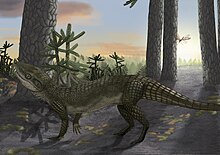| Pakasuchus Temporal range:
| |
|---|---|

| |
| Life restoration of Pakasuchus. | |
| Scientific classification | |
| Domain: | Eukaryota |
| Kingdom: | Animalia |
| Phylum: | Chordata |
| Class: | Reptilia |
| Clade: | Archosauria |
| Clade: | Pseudosuchia |
| Clade: | Crocodylomorpha |
| Clade: | Crocodyliformes |
| Clade: | †Notosuchia |
| Clade: | †Ziphosuchia |
| Genus: | †Pakasuchus O’Connor et al., 2010 |
| Species | |
| |
Pakasuchus is a genus of notosuchian crocodyliform distinguished by its unusual mammal-like appearance, including mammal-like teeth that would have given the animal the ability to chew. It also had long, slender legs and a doglike nose. Fossils have been found in the Galula Formation of Rukwa Rift Basin of southwestern Tanzania, and were described in 2010 in the journal Nature.[1] Pakasuchus is originally considered to lived approximately 105 million years ago, in the mid-Cretaceous,[2] but later age of site is reconsidered to the late Cretaceous, Cenomanian to Campanian instead.[3] The type species is P. kapilimai. Pakasuchus means "cat crocodile" (paka meaning "cat" in Kiswahili) in reference to its catlike skull.[4]
- ^ O’Connor, P.M.; Sertich, J.W.; Stevens, N.J.; Roberts, E.M.; Gottfried, M.D.; Hieronymus, T.L.; Jinnah, Z.A.; Ridgely, R.; Ngasala, S.E.; Temba, J. (2010). "The evolution of mammal-like crocodyliforms in the Cretaceous Period of Gondwana". Nature. 466 (7307): 748–751. Bibcode:2010Natur.466..748O. doi:10.1038/nature09061. PMID 20686573. S2CID 4405106.
- ^ Ker Than (4 August 2010). "Fossil "Cat Crocodile" Had Mammal-like Teeth". National Geographic Daily News. Archived from the original on August 5, 2010.
- ^ Widlansky, Sarah J.; Clyde, William C.; O'Connor, Patrick M.; Roberts, Eric M.; Stevens, Nancy J. (2018-03-01). "Paleomagnetism of the Cretaceous Galula Formation and implications for vertebrate evolution". Journal of African Earth Sciences. 139: 403–420. doi:10.1016/j.jafrearsci.2017.11.029. ISSN 1464-343X.
- ^ Bonner, John (4 August 2010). "Tooth to tail oddities in ancient croc". Nature News. doi:10.1038/news.2010.389.